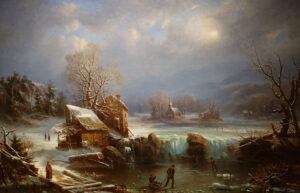Our Northern Hemisphere nights have grown increasingly longer each night since the Solstice of Midsummer in June, six months ago. Back then the days were long and night was swift and fleeting, barely long enough for a midsummer night’s dream to take hold and manifest. But balance is key to this old earth and now, the opposite is true. I have a new friend in Anchorage who told me, at the beginning of December, that the sun there was rising around 9 in the morning and setting around 3 in the afternoon. She showed me the landscape outside her window: snow, everywhere. It was beautiful. Since then, the nights have grown even longer, and the sun has sunk even closer to the horizon, and it is even snowier, as snow had fallen, snow on snow, snow on snow.
This is the bleak midwinter Christina Rossetti wrote about in her song, which still we sing each Christmas in dark, candlelit churches. Bleak in some ways, so achingly beautiful in others. And come Tuesday, we reach the moment when the sun sinks as far south as it will on the horizon. It will appear, to those who watch these things closely, to stand still for a few days as the sinking ceases and reverses course, and there you have a rough translation of the word solstice: sun stand still. In the grand celestial mechanics of the event, though, the sun is a constant; it is our planet, tilted as it is on its axis at about 23.5 degrees, that causes the sun to appear to track lower each day on the approach to solstice. As we spend our year revolving around the sun, the pole that is tilted toward the sun experiences spring and summer, the pole that is tilted away experiences autumn and winter. It is that simple, yet that sublime. Nothing stays the same, and yet nothing really changes. That is the paradox of our round of the year, and that is the paradox of a tilted axis, too. It is sublime, and divine, and it is the beauty of physics and science. How wonderful (how completely filled with wonder) is that?
The solstice moment this time around is Tuesday December 21 at 10:59 AM here in Lake Worth, which is Eastern Standard Time. If you care to mark the moment, calculate from there. To be sure, there are subtle variations of time within each time zone, but I am more of a roundabout kind of guy and prefer to take a roundabout approach. A simple pause at 10:59 AM Eastern is, I feel, a suitable acknowledgment. And then later, under cover of night, Seth and I will build a fire in the copper fire bowl in the backyard. The fire will be fueled by what is left of last year’s Christmas tree. It’s been sitting in a corner of the yard, beneath the mango tree all this year, drying and seasoning, smelling for all the world sometimes like Christmas, which is not so unwelcome in the heat of July as you happen to brush up against it. It’s served as a shelter, a place for small birds to light upon and rest for a moment, and now, its branches bare of fir needles, it will illuminate our longest, darkest night and bring warmth to body and soul, accompanied by some strong Christmas ale or a cup of mulled wine, and our hearty toast: Wassail! Be of good cheer! Welcome Yule!
Out of these darkest nights come some of our deepest joys: all of the celebrations of Midwinter that have come to pass and that are on the horizon. The feasts of St. Nicholas, of Santa Lucia, and of Our Lady of Guadalupe; the eight nights of Chanukah; the ever increasing light of Advent, and still ahead, Christmas Eve and Christmas Day and the Twelve Days of Christmas that follow. These are days and nights of adding our light to the sum of light, of understanding that joy comes out of our countering what is dark with light. When I speak of celebrating a Slow Christmas, this is what I’m really talking about: taking things slow and taking it all in. Being present to the inevitably increasing darkness, acknowledging the need within to combat it with more and more light before we dive headlong into joy. No matter if your celebration is a religious or secular one, the joy of Christmas is a bit meaningless without this. Are you ready for the story to begin again?
Well then. Here we go: It is the same story that never grows old, as this old earth heaves and sighs and spins on its axis, its own beautiful mystery. It matters not so much who or what set it all in motion; it just is, and we acknowledge this, we take it as a blessing, we send the warmth and love in our hearts out upon its vast rotation and all the people and animals and trees that live upon it, and out unto all the mysterious celestial mechanics that create our existence. For this moment, the troubles of our small planet get to feel insignificant, as we tune into the vastness of all that is and ever was and still will be.
Image: “Midwinter Moonlight” by Régis François Gignoux. Oil on canvas, circa mid 19th century [Public domain] via Wikimedia Commons.
